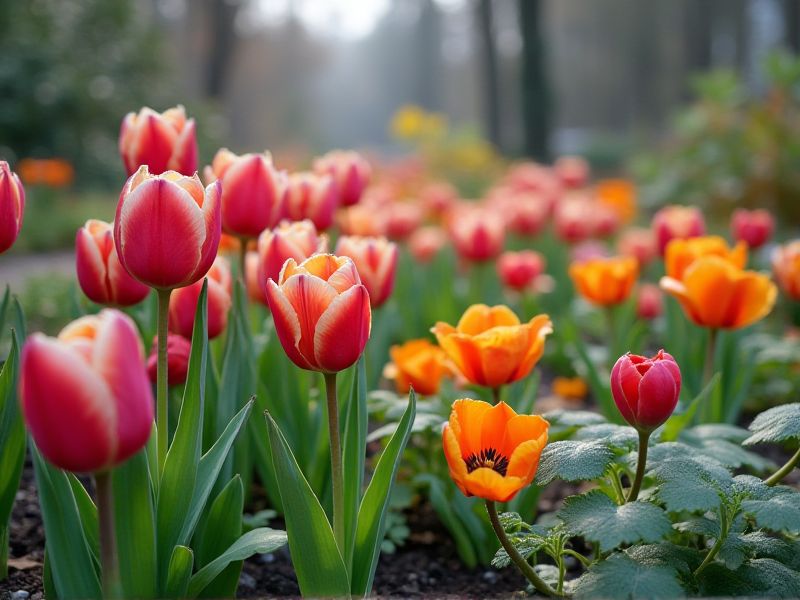
Ornamental plants that thrive in winter conditions include evergreen varieties like holly, boxwood, and juniper, which retain their foliage year-round. Certain perennials, such as hellebores and winter jasmine, bloom during the colder months, adding color to your garden. Incorporating plants like ornamental grasses not only creates visual interest but also provides structure to your landscape in winter. Understanding USDA hardiness zones can help you select the best winter-hardy plants for your location. To ensure the health of these plants, consider mulching around their base to protect their roots from harsh temperature fluctuations.
List of some Ornamental plants that survive winter
- Boxwood (Buxus sempervirens)
- Japanese Maple (Acer palmatum)
- Holly (Ilex aquifolium)
- Yew (Taxus baccata)
- Hellebore (Helleborus niger)
- Coral Bells (Heuchera)
- Winter Jasmine (Jasminum nudiflorum)
- Camellia (Camellia japonica)
- Snowdrop (Galanthus nivalis)
- Witch Hazel (Hamamelis virginiana)
Important things about Ornamental plants that survive winter
Hardiness Zones
Ornamental plants suitable for winter survival thrive in specific hardiness zones, which categorize climate conditions based on temperature extremes. For instance, zones 3 to 7 are ideal for popular winter-hardy species such as Hellebores, Sedum, and various evergreens like Boxwood. When selecting plants, consider their cold tolerance, as this ensures they can withstand harsh winter conditions and rejuvenate in the spring. You can enhance the durability of your garden by incorporating these resilient plants, providing year-round beauty and structure.
Deciduous Vs. Evergreen
Deciduous ornamental plants, such as maples and dogwoods, shed their leaves in autumn, entering a dormant state that protects them during winter's harsh conditions. In contrast, evergreen plants like boxwoods and hollies retain their foliage year-round, providing continuous visual interest and structure even in snowy landscapes. Your choice between these types significantly impacts winter garden aesthetics and habitat biodiversity. Understanding the characteristics of both groups helps you select the best plants to enhance your landscape throughout the seasons.
Mulching Techniques
Applying mulching techniques effectively protects ornamental plants during winter months, ensuring their resilience and vibrancy when spring arrives. Organic materials, such as shredded bark or wood chips, provide insulation against freezing temperatures while also enriching the soil as they decompose. When applying mulch, aim for a thickness of 2-4 inches, maintaining a gap around the plant's base to prevent rot. This practice not only conserves soil moisture but also reduces weeds, allowing your ornamental plants to thrive with minimal competition.
Insulation Methods
Insulating your ornamental plants during winter is essential for maintaining their health and vitality. Techniques such as mulching create a protective barrier that helps retain soil warmth and moisture, essential for preventing frost damage. Using burlap wraps or frost cloths around sensitive plants can shield them from harsh winds and extreme cold temperatures, ensuring their survival through winter. You should also consider relocating potted plants to sheltered areas, such as porches or garages, to further enhance their winter protection.
Watering Requirements
Ornamental plants that survive winter often have specific watering requirements to thrive during the colder months. Maintaining adequate soil moisture is crucial, as overwatering can lead to root rot, while underwatering can stress the plants. Watering early in the day when temperatures are still cool helps prevent frost from forming on wet foliage. You should also consider using mulch to retain soil moisture and regulate temperature around these hardy ornamental plants.
Sunlight Exposure
Ornamental plants that survive winter, such as hellebores and winter jasmine, thrive best with adequate sunlight exposure, which is essential for their health and vibrancy. These hardy species often require a minimum of four to six hours of direct sunlight daily to strengthen their root systems and support blooming in early spring. Ensuring your plants receive proper light can enhance their resilience against freezing temperatures and promote robust growth. Consider planting them in locations that benefit from natural sunlight, such as south-facing gardens or near windows that allow light penetration.
Soil Drainage
Proper soil drainage is essential for ensuring the health of ornamental plants that withstand winter conditions. Plants like Hellebores and Sedum thrive in well-draining soil, as it prevents root rot and ensures adequate aeration during cold months. Incorporating organic matter, such as compost or peat moss, can enhance drainage while providing essential nutrients for winter resilience. To improve drainage, consider amending heavy or clay soils with sand or gravel, promoting a thriving environment for your ornamental winter garden.
Pruning Strategies
Pruning strategies for ornamental plants resilient in winter are essential for maintaining their health and beauty. Early spring is often the recommended time for pruning deciduous varieties, allowing for the removal of dead or damaged branches while encouraging new growth. Techniques such as heading back or thinning out can enhance airflow and light penetration, reducing the risk of disease. You should consider specific plant requirements, as certain species may benefit from more aggressive pruning while others thrive with minimal intervention.
Pest And Disease Resistance
Ornamental plants that survive winter, such as hellebores and winter jasmine, demonstrate remarkable pest and disease resistance, making them ideal for cold climates. These resilient species often possess natural defenses, including thick cuticles and antifungal properties, that help them endure harsh conditions while minimizing health risks. You can enhance these plants' resilience by providing proper care during the offseason, such as mulching and selecting disease-resistant varieties. By choosing ornamental plants with proven resistance traits, your winter landscape can thrive despite potential pest and disease challenges.
Seasonal Care Routines
Ornamental plants like Pansies, Hellebores, and Winter Heath can thrive even in harsh winter conditions, showcasing resilience and beauty during the colder months. To ensure their survival, it is essential to provide proper mulching and adequate drainage, as excess moisture can lead to root rot. During winter, you should monitor soil moisture levels carefully, ensuring they do not dry out completely or become overly saturated. As winter progresses, consider providing protection against frost with burlap or frost cloth to maintain optimal growth conditions for these hardy plants.
